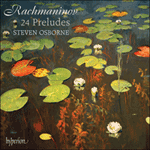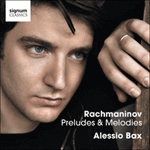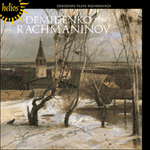
Welcome to Hyperion Records, an independent British classical label devoted to presenting high-quality recordings of music of all styles and from all periods from the twelfth century to the twenty-first.
Hyperion offers both CDs, and downloads in a number of formats. The site is also available in several languages.
Please use the dropdown buttons to set your preferred options, or use the checkbox to accept the defaults.

| Steven Osborne (piano)» More |
The opening Preludes of Op 23 establish three archetypes for the entire set. The sighing motifs of the slow F sharp minor, No 1, define a tone of melancholy introspection, while the florid arpeggios, indomitable chords and luxuriant final cascades of the fast B flat major, No 2, are redolent of a determination to master any adversity; No 3 in D minor, Tempo di minuetto, mediates between the extremes, its centre of gravity being a restrained neo-classicism that can shade into introversion or extroversion at will. The template established in these three opening Preludes is followed by the next four. No 4 is a Schumannesque song without words (compare the second of Schumann’s Romanzen Op 28), while the famous G minor Alla marcia frames melting lyricism with militant energy; the neo-Baroque phase then has to wait while the sighing lyrical E flat Prelude once again demonstrates Rachmaninov’s mastery of decorative accompaniment. When the maximalized Bachian toccata style of the C minor Prelude No 7 arrives, it does so as a tour de force. The last three Preludes in the Op 23 set are anything but anticlimactic. The A flat major No 8 sticks to its right-hand figuration as tenaciously, yet as resourcefully, as a Chopin Study, while the double notes of the Presto E flat minor are an earthier reincarnation of Liszt’s Feux follets (Will-o’-the-wisps) from the Transcendental Studies. Finally the slow G flat major avoids applause-orientated strategies and instead modestly closes the frame of the opus, reworking the sighs of the opening F sharp minor Prelude.
from notes by David Fanning © 2009
Les premiers préludes de l’Opus 23 établissent trois archétypes pour l’ensemble du recueil. Les motifs soupirants du lent Prélude no 1 en fa dièse mineur définissent un ton d’introspection mélancolique, alors que les arpèges fleuris, les accords invincibles et les cascades finales luxuriantes du rapide Prélude no 2 en si bémol majeur évoquent une détermination à maîtriser toute forme d’adversité; le no 3 en ré mineur, Tempo di minuetto, sert d’intermédiaire entre les extrêmes, son centre de gravité étant un néoclassicisme retenu qui peut se fondre à volonté en introversion ou extraversion. Le modèle créé dans ces trois premiers préludes se retrouve dans les quatre autres. Le no 4 est une mélodie sans paroles schumannienne (à comparer à la deuxième des Romanzen, op. 28, de Schumann), alors que la célèbre Alla marcia en sol mineur formule un lyrisme attendri avec une énergie militante; la phase néobaroque doit ensuite attendre le temps que le Prélude en mi bémol majeur au lyrisme attendrissant prouve une fois encore la maîtrise qu’avait Rachmaninov de l’accompagnement décoratif. Lorsque survient le Prélude no 7 en ut mineur à la manière d’une toccata dans le plus pur style de Bach, il s’impose comme un tour de force. Les trois derniers préludes de l’Opus 23 sont tout sauf décevants. Le Prélude no 8 en la bémol majeur s’en tient à sa figuration de la main droite avec autant de ténacité et d’ingéniosité qu’une étude de Chopin, alors que les doubles notes du Prélude Presto en mi bémol mineur sont une réincarnation plus truculente de Feux follets des Études d’exécution transcendante de Liszt. Enfin, le lent Prélude en sol bémol majeur évite les stratégies visant à susciter des applaudissements pour clore modestement l’ensemble de l’opus, en retravaillant les soupirs du Prélude en fa dièse mineur initial.
extrait des notes rédigées par David Fanning © 2009
Français: Marie-Stella Pâris
Die Anfangspréludes von op. 23 können als Modellstücke für den gesamten Zyklus gesehen werden. Die Seufzermotive des langsamen fis-Moll Stücks, Nr. 1, geben einen melancholischen, introspektiven Ton vor, während die blumigen Arpeggien, unbezähmbaren Akkorde und üppigen Schlusskaskaden des schnellen B-Dur Préludes, Nr. 2, eine Entschlossenheit, jegliches Missgeschick zu bewältigen, auszudrücken scheinen. Nr. 3 in d-Moll, Tempo di minuetto, vermittelt zwischen den beiden Extremen; hier ist der Schwerpunkt ein beherrschter Neoklassizismus, der sowohl mal introvertiert als auch mal extravertiert wirken kann. Die Vorgabe, die in diesen ersten drei Préludes festgelegt wird, erscheint dann auch in den folgenden vier Stücken; Nr. 4 ist ein Schumanneskes Lied ohne Worte (vgl. die Nr. 2 aus Schumanns Romanzen op. 28), während das berühmte Alla marcia in g-Moll dahinschmelzende Lyrik mit militanter Energie umrahmt; die neobarocke Phase muss dann warten, während das seufzende, lyrische Es-Dur Prélude wiederum Rachmaninows meisterliche Gabe der ausgeschmückten Begleitung beweist. Der bis aufs Äußerste ausgedehnte Bach’sche Toccatenstil im c-Moll Prélude Nr. 7 ist eine Meisterleistung. Die letzten drei Préludes des Zyklus op. 23 sind alles andere als eine Antiklimax. Im As-Dur Stück Nr. 8 erklingen die Figurationen der rechten Hand ebenso beharrlich einerseits und erfinderisch andererseits wie in einer Chopin-Etüde, während die Intervallketten des Presto in es-Moll eine etwas derbere Reinkarnation von Liszts Feux follets (Irrlichter) aus den Transzendentalen Etüden sind. Das langsame Ges-Dur Prélude schließlich ist nicht applausstrategisch angelegt, sondern beendet das Opus auf bescheidene Art und Weise und bezieht sich noch einmal auf die Seufzer des ersten Préludes in fis-Moll zurück.
aus dem Begleittext von David Fanning © 2009
Deutsch: Viola Scheffel
 Rachmaninov: 24 Preludes Rachmaninov: 24 PreludesSteven Osborne’s live performances of Rachmaninov’s preludes were greeted ecstatically by critics and audience alike: a new benchmark for performances of these works, and a new departure for this most subtle and sensitive of pianists. Now Steven h ...» More |
 Rachmaninov: Preludes & Melodies Rachmaninov: Preludes & MelodiesIn his second solo piano recital album for Signum, Alessio Bax further demonstrates his dazzling skill and flair in performance and interpretation—this time with Rachmaninov’s piano works. Centered around the Preludes op 23, the programme is descr ...» More |
 Rachmaninov: The Complete Solo Piano Music Rachmaninov: The Complete Solo Piano Music‘A fine achievement from Howard Shelley and Hyperion alike. These superbly recorded, idiomatic readings demonstrate Shelley's virtuoso pianism and aff ... ‘A significant testimony to Howard Shelley's artistry. Pianistically impeccable, he understands what Rachmaninov was about’ (Gramophone)» More |
 Rachmaninov: Demidenko plays Rachmaninov Rachmaninov: Demidenko plays Rachmaninov‘A marvellous disc … this excellently chosen selection of Rachmnaninov's finest solo piano works is played with superb panache by Demidenko ... ‘A marvellous disc’ (BBC Music Magazine)» More |
 Rachmaninov: Piano Music Rachmaninov: Piano MusicJeremy Filsell is one of very few performers to have established a virtuoso concert career as both a pianist and organist on the international stage. This recital album explores Filsell's lifelong love of Rachmaninov's piano music, surveying selec ...» More |
 Lullabies for Mila Lullabies for MilaFrom acclaimed pianist Alessio Bax, this new compilation presents a lovingly curated playlist of soothing classics—to calm a baby or an adult, with music from Bach and Brahms to Rachmaninov and Scriabin.» More |

